Scraping and Rendering HTML in iPython Notebook
April 11, 2016
Requirements:
You need to have to have selenium installed first: run pip install selenium in the terminal or with iPython run !pip install selenium.
Getting an HTML selection with selenium
First, set up a Firefox webdriver and point it to our URL of interest.
from selenium import webdriver
driver = webdriver.Firefox()
driver.get('https://en.wikipedia.org/wiki/International_Space_Station')
Let's select the first <table> element from Wikipedia's ISS article as an example.
iss_table = driver.find_element_by_xpath('//table')
Now we want to see if our XPath selector got us what we were looking for.
We can look at the raw HTML of that first <table> and see it it's what we wanted. To get the raw HTML of a selected element, we can get its outerHTML attribute:
iss_table_html = iss_table.get_attribute('outerHTML')
print iss_table_html[:200]
print '\n. . .\n'
print iss_table_html[-200:]
<table class="infobox" style="font-size:88%; width:22em; text-align:left">
<caption>International Space Station</caption>
<tbody><tr>
<td colspan="3" style="text-align:center;"><a href="/wiki/File:Int
. . .
ex.php?title=International_Space_Station&action=edit">[update]</a></sup><br>
(<a href="/wiki/Exploded_view" title="Exploded view" class="mw-redirect">exploded view</a>)</td>
</tr>
</tbody></table>
Rendering the selected HTML in the notebook
Reading raw HTML isn't very nice.
Let's take advantage of some iPython Notebook magic: since we're viewing the notebook in a web browser, we can also render HTML content directly in the notebook.
We lose whatever CSS styling was in the scraped website, as well as anything loaded from relative links, but we can see the general structure which is often all we want anyway.
This can make it much easier to see what our XPath selectors are actually pulling from the site. Is it what we intended? Scraping HTML is a messy business and selectors often surprise you, so it's nice to be able to get visual feedback.
Here is the same table as above, rendered in HTML in the iPython notebook. Relative links won't work, but in the example below the image of the ISS shows up correctly because its src is an absolute link.
# for ipython notebook display
from IPython.core.display import display, HTML
display(HTML(iss_table_html))
 |
||
| The International Space Station on 23 May 2010 as seen from the departing Space Shuttle Atlantis during STS-132. | ||
| Station statistics | ||
|---|---|---|
| COSPAR ID | 1998-067A | |
| Call sign | Alpha, Station | |
| Crew | Fully crewed: 6 Currently aboard: 6 (Expedition 47) |
|
| Launch | 20 November 1998 | |
| Launch pad | Baikonur 1/5 and 81/23 Kennedy LC-39 |
|
| Mass | Appx. 419,455 kg (924,740 lb)[1] | |
| Length | 72.8 m (239 ft) | |
| Width | 108.5 m (356 ft) | |
| Height | c. 20 m (c. 66 ft) nadir–zenith, arrays forward–aft (27 November 2009)[dated info] |
|
| Pressurised volume | 916 m3 (32,300 cu ft) (3 November 2014) |
|
| Atmospheric pressure | 101.3 kPa (29.91 inHg, 1 atm) | |
| Perigee | 409 km (254 mi) AMSL[2] | |
| Apogee | 416 km (258 mi) AMSL[2] | |
| Orbital inclination | 51.65 degrees[2] | |
| Average speed | 7.66 kilometres per second (27,600 km/h; 17,100 mph)[2] | |
| Orbital period | 92.69 minutes[2] | |
| Orbit epoch | 25 January 2015[2] | |
| Days in orbit | 6353 (12 April) |
|
| Days occupied | 5640 (12 April) |
|
| Number of orbits | 95912[2] | |
| Orbital decay | 2 km/month | |
| Statistics as of 9 March 2011 (unless noted otherwise) |
||
| References: [1][2][3][4][5][6] | ||
| Configuration | ||
 |
||
| Station elements as of May 2015[update] (exploded view) |
||
Much nicer!
